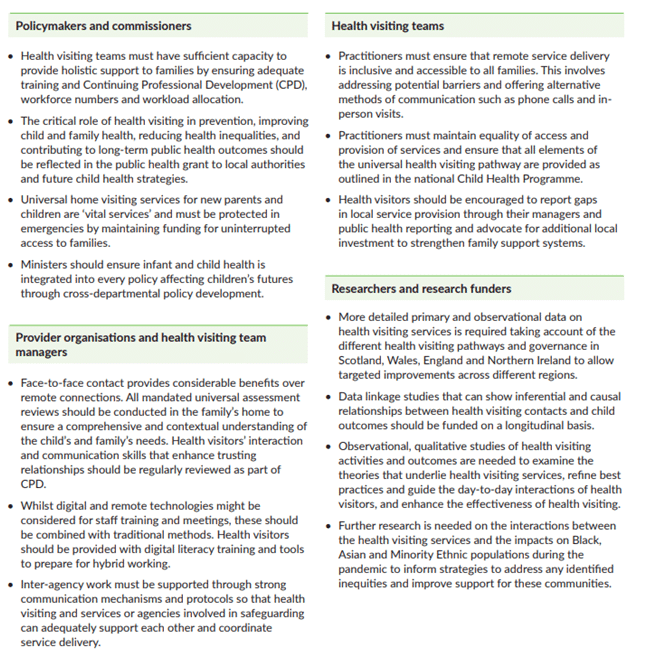18th November 2024
This guest iHV Voices blog, by Dr Erica Gadsby, Associate Professor of Public Health | Director of the online Master of Public Health (MPH) Programme, University of Stirling, provides an overview of the recently published findings and recommendations from the NIHR funded research, ‘Realist Review: Health visiting in light of the COVID-19 Pandemic Experience (RReHOPE)’.

Dr Erica Gadsby, Associate Professor of Public Health | Director of the online Master of Public Health (MPH) Programme, University of Stirling
During the COVID-19 pandemic health visiting services in many areas adapted to work in new ways. We also saw significant variability between and within the four countries in the United Kingdom. Our study set out to learn from health visiting teams’ experiences of the pandemic across the UK, to develop ideas about how best to organise and deliver health visiting services in the future.
Due to the complexity of health visiting services we chose to use a realist review of the literature. A realist review is a systematic and theory-driven approach to synthesising and analysing evidence. It focuses on understanding how complex interventions work in particular contexts, by examining the underlying mechanisms and contextual factors. The involvement of stakeholders in a realist review is crucial and we involved parents with experience of caring for a baby during the pandemic, health visitors, and professional stakeholders.
In total we reviewed 118 documents, including reports written by practitioners and advocacy charities, policy documents and previous academic research. Most of the documents that we found were from England and we did not find many documents on changes during the pandemic at a local management level. This limited what we could learn, but it is also useful to reflect on the type of documents that are published and the UK countries that they focus on.
Our findings fell into three main themes:
Health visiting contacts: This theme emphasised the importance of relationships between health visitors and families. The skill of building and maintaining trusting relationships was the priority, whether the contact was face-to-face or via remote or online methods.
Health visiting connections: This theme highlighted the importance of the dynamic process of holistic assessments, conducted by health visitors, in the baby’s home setting. The health visitor’s connection to the family context and to the services and support available in the local community are vital for ensuring needs for support are met.
Health visiting workforce: This final theme highlighted the wide variation in health visiting service delivery and the range of ways the pandemic impacted health visiting work. We identified some key distinctions between the imagined and prescribed work of health visitors, and that which is disclosed and ‘done’ in practice.
The COVID-19 pandemic rapidly and dramatically altered the context in which health visiting services are delivered. The impact of the pandemic on babies and families has been far-reaching, uneven and enduring. We found that health visiting staff rapidly adapted, finding new ways to ensure that babies and families continued to receive support in different contexts. However, the variation in practice and service delivery across the UK has been amplified, and there are important and ongoing implications of the pandemic response for future service delivery. At the end of our study, we made wide-ranging recommendations for policy makers and commissioners, for provider organisations and team managers, for health visiting teams and for researchers. These include some key priorities to protect the vital role carried out by health visitors across the UK.
The research, ‘Realist Review: Health visiting in light of the COVID-19 Pandemic Experience (RReHOPE)’, can be read in full via the Health and Social Care Delivery Research Journal here.








